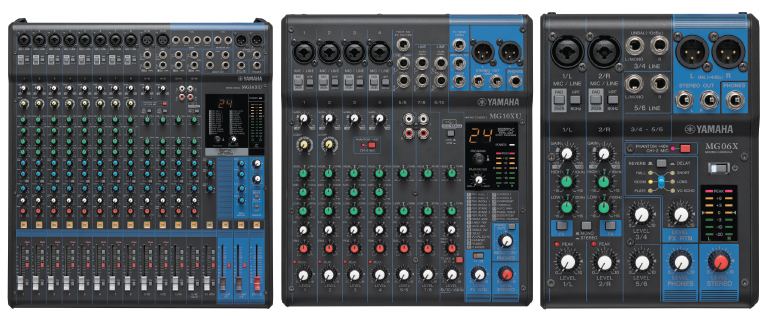 Few companies in the music products industry are as diversified—or as well respected, for that matter—as Yamaha, a firm whose enviable expertise spans such disparate categories as guitars, drums, keyboards, amplifiers, pianos, software and more. So, when Yamaha announces its excitement about a NAMM show product launch, the possibilities are virtually limitless for what its innovative R&D experts have crafted. This time, all eyes are on the new generation of the MG mixer series: small-format mixing consoles that provide compact, cost-effective, great-sounding solutions for live, recording or install settings. To get the skinny on the redesigned MG series mixers, The Retailer caught up with John Schauer, Product Manager, Live Sound, Yamaha Corp. of America.
Few companies in the music products industry are as diversified—or as well respected, for that matter—as Yamaha, a firm whose enviable expertise spans such disparate categories as guitars, drums, keyboards, amplifiers, pianos, software and more. So, when Yamaha announces its excitement about a NAMM show product launch, the possibilities are virtually limitless for what its innovative R&D experts have crafted. This time, all eyes are on the new generation of the MG mixer series: small-format mixing consoles that provide compact, cost-effective, great-sounding solutions for live, recording or install settings. To get the skinny on the redesigned MG series mixers, The Retailer caught up with John Schauer, Product Manager, Live Sound, Yamaha Corp. of America.
The first question The Retailer posed to Schauer was why now is a particularly opportune time to release a mixing console series in the small-format, portable category. In response, he cited Yamaha’s over-40-year involvement in professional audio, during which time the company’s gotten a great deal of input from dealers and end users, enabling it to develop and improve its products to meet musicians and sound engineers’ needs. According to Schauer, “In the past few years, the acceptance of self-powered loudspeakers with built-in amplification has grown dramatically. Many of these applications require a mixer to complete the system. Customers are benefitting from much higher quality audio, and we felt the time was right to refresh the MG mixer line-up to complement this trend.”
Work on the new MG series started almost immediately after the launch of the previous models, owing to Yamaha’s desire to improve on each point after a product’s release, particularly when, as in this case, the product’s been successful. “We wanted to take advantage of the advancements in component and circuit designs and also increase fidelity, reducing distortion and noise,” Schauer remarked. Moreover, the mixers represent the company’s desire to offer the best quality and cleanest audio performance to customers who are not necessarily audio savvy. “But just because the MG mixers are smaller doesn’t mean that our high standards have been lowered,” Schauer stressed. “We wanted to…build strong workhorse mixers that will last a long time and that can be counted on to perform every night.”
Although we’ll get into more detail later, for now let’s take a wide view of the MG series. It is broken up into three categories: six-channel models (with and without digital effects); standard models; and XU versions that incorporate digital effects and USB I/O for computer connectivity. The MG06 and MG06X both offer two microphone and two stereo inputs for the smallest of applications; the MG06X adds digital effects. Turning to the standard models, the MG10 offers four microphone inputs (two with single-knob compression) and three stereo inputs. Next is the MG12, with six microphone inputs (four with single-knob compression). The MG16 offers 10 microphone inputs (eight with single-knob compression) and three stereo inputs. Finally, the MG20 has 16 microphone inputs (eight with single-knob compression) and two stereo inputs.
The XU versions start with the MG10XU, offering four microphone inputs (two with single-knob compression) and three stereo inputs, USB connectivity and digital effects. Next is the MG12XU, with six microphone inputs (four with single-knob compression), also with USB I/O and digital effects. The MG16XU takes things up to 10 microphone inputs (eight with single-knob compression) and three stereo inputs, USB I/O and digital effects. Finally, the MG20XU has 16 microphone inputs (eight with single-knob compression), USB I/O, digital effects and two stereo inputs.
In total, then, the series is composed of 10 models that, through features like studio-quality preamps, powerful digital signal processing and rugged construction, share a pedigree with Yamaha’s higher-end mixer lines. “We added features pioneered on those models into these mixers,” Schauer explained. Yamaha was able to control costs by limiting the number of channels that offer single-knob compression. “Our SPX digital effect, offered on the XU models, is also an example of our technology being exploited for its great sound quality, while limiting some of the adjustability that would add cost,” he continued. “The result? Great-sounding effects that anyone will appreciate.” More on SPX just a few paragraphs down.
Plumbing the series’ technical details, the MG06 and MG06X mixers offer a metal chassis that allows them to stand up to the road and reject interference more effectively. “A feature you’ll see right away is they offer XLR balanced outputs,” stated Schauer, “which speaks of their professional design heritage.” Both models are mountable on a microphone stand (with an optional bracket), enabling them to be right at the fingertips of the performer.
Single-knob compression, which the standard models begin to introduce, is, according to Schauer, “a great feature for taming an unruly vocal or for bringing out a bass guitar in the mix. Before we offered this feature, a user would need to buy an outboard device and learn to set many controls. Often, the complexity of these devices led to less-than-appropriate sound, and


